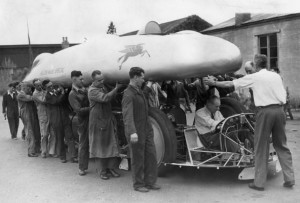Real Speed
I recently bought a book published in 1950. Called Speed – the Book of Racing and Records, it covers fast machines on both land and water.
Written at a time when the United Kingdom held most of the records, it’s a brilliant read as the contributors are often the men who held the records. One of the best chapters is by John Cobb, then the holder of the world Land Speed Record.
Here it is.
The idea of building a new kind of car to attack the World’s Land Speed Record, which is the out-and-out fastest that any car of any size has ever travelled on the earth, came when I was driving my big 500h.p. Napier-Railton at Brooklands Track.
This very large car had been constructed for me to designs by my friend Reid Railton, an engineer whose talents, in my opinion, amount to sheer genius. The car was born on a drawing board and although I was perhaps a little dubious about its possible performance, everything that Railton said it would do it did – and rather more. It was admiration for his brains that led me to think that if ever a man could design a car to beat the World’s Record, then held at 300 m.p.h. by Sir Malcolm Campbell’s “Blue Bird”, that man was Reid Railton.
As things turned out, the car he designed for me did exactly as he said; in fact, his theoretical prophecies were rather on the pessimistic side and the car did better than he expected.
I think a few words about the car – which I called “The Railton” in his honour – will interest you because it is a most unusual design. It is, for instance, interesting that my 3-ton car was half the weight of Eyston’s “Thunderbolt” and had only half the power.
 Railton had to start planning the car on two things – the tyres which were available for the job, and the somewhat old-fashioned Napier Lion aero engines which were all I could get, and both these things meant that the weight of the car had to be as low as possible to get the speeds we were after. Such speeds were obtained by perfect stream-lining.
Railton had to start planning the car on two things – the tyres which were available for the job, and the somewhat old-fashioned Napier Lion aero engines which were all I could get, and both these things meant that the weight of the car had to be as low as possible to get the speeds we were after. Such speeds were obtained by perfect stream-lining.
First of all, the car has no chassis frame like ordinary cars. Instead, there is a single backbone girder down the middle. This is “kinked” in the middle so that the two engines can be slung alongside the girder, one each side and back to back, running in opposite directions. This arrangement balances out the twisting action of an engine when it is working and makes the car very steady to drive.
Next, one engine drives the back wheels and the other drives the front wheels, and this four-wheel drive makes it possible to use full power for gaining speed without the danger of the wheels merely spinning round and slipping on the ground. The engines are supercharged at a fairly low pressure and each one gives 1,400 h.p.
I had two three-speed gearboxes with a very high top gear, and I could do about 250 m.p.h. in middle gear!
The body is a very special streamlined design, made after a long series of careful scientific tests with models in a wind tunnel. It is very light and it fits down over the whole car, with a very long, streamlined tail. My driving seat is right out in the nose of the car, ahead of the front wheels, and my head is covered in a streamlined conning-tower.
From start to finish, it took three years to plan and build the car.
There is, so far as is known, only one place on earth where records at such high speeds can be done, and that is the dry bed of a salt lake in Utah, U.S.A. It is under water part of the year, but when it dries out in. the summer, the bed of the lake is made of smooth salt crust which is as nearly perfect for record runs as anything could be.
I first went there in 1938 when I got the record at 350 m.p.h. We altered a few things on the car after that, and in the following year I raised the speed to 369 m.p.h. But all the time I felt sure the car would reach the magic figure of 400 m.p.h. so, after the war, a few details were changed (one thing was a device for preventing the engines from stalling when I changed gear) and in 1947 I went over to Utah a third time.
As you may know, I got the record at 394 m.p.h., average of two runs, and my fastest run in one direction was 403.14 m.p.h. If the salt had been in better condition, for it was beginning to break up and on one stretch was very bumpy, I am convinced that the average for the two runs could have been over 400 m.p.h.
 I have often been asked what that enormous speed feels like, and that is very difficult to put down in words because the sensation is quite out of this world. There is not a lot of room across the lake bed. Given more room to get going, and a longer distance in which to slow down again, the car would go even faster, because it was gaining speed right through the measured mile.
I have often been asked what that enormous speed feels like, and that is very difficult to put down in words because the sensation is quite out of this world. There is not a lot of room across the lake bed. Given more room to get going, and a longer distance in which to slow down again, the car would go even faster, because it was gaining speed right through the measured mile.
I had only six miles to gain speed and this means that I had to use all the power of the car the moment it started off from rest. I cannot describe the feeling of the enormous power except to say that it made any racing car seem like a toy and it was as if a colossal giant was hurling me forward.
At each mile there was a big sign board with the number of miles left to go painted on it. Down the centre of the fairway which had been swept clear of loose salt there was a big black line, and I sat the car across this, astride, as it were. I focused my eyes about a quarter of a mile ahead. The instant I spotted the mile-post next ahead, it shot towards me and vanished, so fast was my speed, so that I only got a glimpse of each board in turn, and the miles in between flashed past like a hundred yards instead of 1,760 of them. Each mile was taking about 10 seconds!
The car was amazingly steady, thanks to the four-wheel drive design and the counter-balanced engines. I changed up into middle gear at about 120 m.p.h. then, a few seconds later, at 250 m.p.h., I snicked into top gear, and then the engines really took hold and hurled me along faster and faster.
The black line unreeled under the wheels, the mile posts flicked at me and were gone, I had a vague impression of a misty horizon in the distance and down each side of the 40-foot swept track it was rather like a thick fog, for I could see nothing at all. I had to steer the car constantly, just like keeping a touring car straight, because I dare not lose that unwinding black line which alone kept me going in a straight line.
 Suddenly the start of the measured mile flashed up and was gone after my six miles run-in, and now the car really was going. The roar of the, engines just behind my head rose to a deafening thunder (although I wore ear-plugs), and the entire machine vibrated as it shot over some rough surface, whilst the wind rushing past with the force of a hurricane rose to a deafening screech round my conning-tower. By the time you could count nine the end of the measured mile flashed up and was gone, just as the instruments registered 410 m.p.h. and I took my foot off the throttle.
Suddenly the start of the measured mile flashed up and was gone after my six miles run-in, and now the car really was going. The roar of the, engines just behind my head rose to a deafening thunder (although I wore ear-plugs), and the entire machine vibrated as it shot over some rough surface, whilst the wind rushing past with the force of a hurricane rose to a deafening screech round my conning-tower. By the time you could count nine the end of the measured mile flashed up and was gone, just as the instruments registered 410 m.p.h. and I took my foot off the throttle.
Instantly everything went silent. The wind scream died away gradually, the vibration ceased, but I felt as if the car would never even begin to slow down. Mile after mile flicked past and then, when I saw I was down to 300 m.p.h. I jabbed the brake pedal, but it was like jabbing cotton wool—nothing happened at all so far as I could see. Actually, the powerful, water-cooled brakes had slowed me. I jabbed again and again, letting the brakes off in between because the shoes were more than red hot and the cooling water was flashing into steam. Gradually, gradually, I lost pace … 250… 200…and well into the last mile, the speed really fell away. I put the brakes hard on and the car rolled silently to a standstill.
That was the first run. Then the car was turned round, the tyres were changed, other details were seen to and then off I went again, back the way I had come.

 Julian Edgar, 50, has been writing about car modification and automotive technology for nearly 25 years. He has owned cars with two, three, four, five, six and eight cylinders; single turbo, twin turbo, supercharged, diesel and hybrid electric drivelines. He lists his transport interests as turbocharging, aerodynamics, suspension design and human-powered vehicles.
Julian Edgar, 50, has been writing about car modification and automotive technology for nearly 25 years. He has owned cars with two, three, four, five, six and eight cylinders; single turbo, twin turbo, supercharged, diesel and hybrid electric drivelines. He lists his transport interests as turbocharging, aerodynamics, suspension design and human-powered vehicles.

on July 9th, 2008 at 9:42 am
Absolutely freakin awesome.
on July 9th, 2008 at 1:09 pm
The only thing that sounds similar is the recollections of the SR71 pilots.
http://blogs.jobdig.com/wwds/2007/11/19/sr-71-now-that-was-some-airplane/
But of course, they were going fast.
on July 9th, 2008 at 4:22 pm
Wonderful link Dr Pat